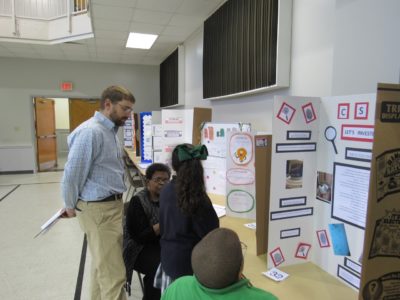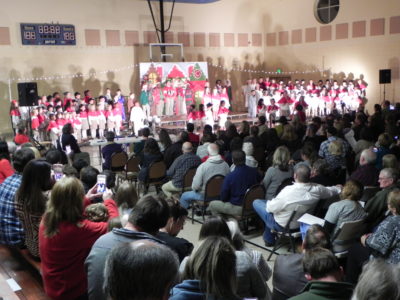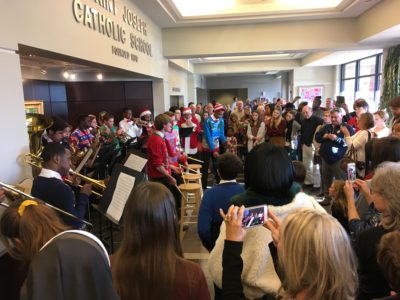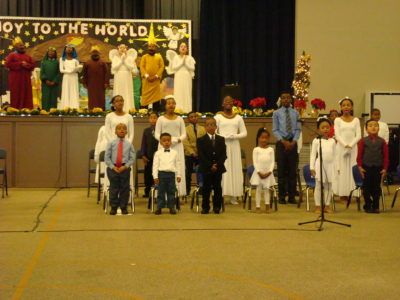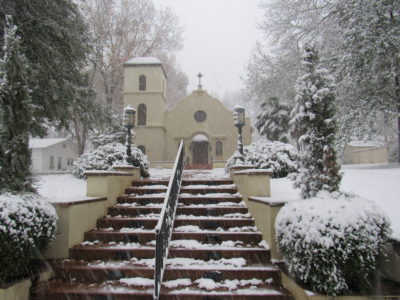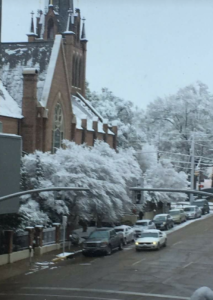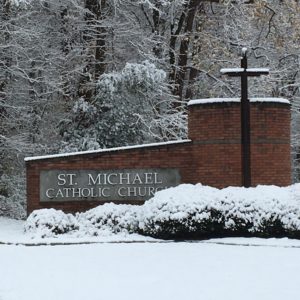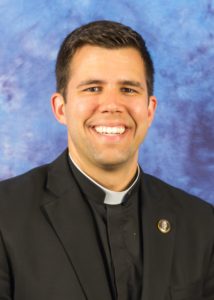By Deacon John McGregor
PEARL – On Saturday, January 6, during Mass at St. Jude Parish, Bishop Joseph Kopacz invited seven men from the Diocese of Jackson to begin the period of prayer and discernment to become permanent deacons. They will join the nine men already serving this diocese as permanent deacons.

PEARL – Bishop Joseph Kopacz blesses brevaries for the seven men who entered the formation program for the permanent diaconate on Saturday, Jan. 6 at St. Jude Parish. The men will use the books to pray the daily prayer of the church, the liturgy of the hours. Visible are David Hoang, Mark Bowden, Kayed Jwainat and Wesley Lindsay. (Photos by Maureen Smith)
The aspirants are Mark Bowden (wife, Rhonda) from Pearl St. Jude Parish; Kayed Jwainat (wife, Cynthia) from Madison St. Francis Parish; John Anh Pham (wife, DiemThuy) from Forest St. Michael Parish; Tony Schmidt (wife, Karen) from Flowood St. Paul Parish; Edwin Antonio Wilson (wife, Kelleigh) from Magee St. Stephen Parish; and from the Cathedral of St. Peter the Apostle, David Hoang (wife, Honghuong) and Wesley Lindsay (not married).
This first year in the five-year process of formation is called aspirancy. During this time the aspirants meet monthly to hear talks on prayer, discernment and the ministry of the diaconate. This period is also a time for diocesan leadership to discern if the aspirants demonstrate and articulate an authentic call to ordination.
The process began when the candidates submitted a lengthy application including letters of recommendation. After all the documentation was received, each nominee and his wife were first interviewed by a diocesan permanent deacon and his wife and then by a diocesan priest. Following these two interviews, each candidate took a battery of psychological tests and interviewed with a psychologist. Finally, the candidates interviewed with the diocesan Diaconate Vocations Board, Father Kevin Slattery, the vicar general, and Bishop Kopacz.
On June 18, 1967, Pope Paul VI issued the Motu Proprio, Sacrum Diaconatus Ordinem restoring the diaconate as a permanent degree of holy orders. Although the permanent diaconate can trace its origins back to the Book of Acts, the diaconate eventually became a transitional rank for men who aspired to be priests. A man who enters the seminary and studies to become a priest, will be ordained a transitional deacon about a year before his ordination to the priesthood. A permanent deacon does not aspire to become a priest but rather chooses to remain at the service of the Church, in a special relationship with the bishop. A permanent deacon may be married or single and is at least 35 years of age but not older than 60 at the time of ordination.
The role of the wife is an essential part of the formation process. Not only is her consent and support necessary, she will share in her husband’s ministry. While the exact nature of the wife’s role varies widely, it is most effectively lived out in their ministry as husband and wife, committed to their marriage as the primary vocation in their lives, and to service to the Church as a natural part of the life-giving nature of their marital vocation.
Most permanent deacons have regular secular jobs in order to provide for their families. In addition to their secular work they are assigned by the bishop to serve the diocese in parishes, hospitals, schools, prisons and other places where their skills and the diocese’s needs coincide. Deacons are ordained for the works of word, liturgy, and charity. Their lives are one of commitment to the church as servants in imitation of Christ the servant.
Once the seven men complete the period of aspirancy, they may petition the bishop for admission to candidacy. The petitioner’s wife (if he is married) must also submit a handwritten letter of consent.
The petitioner will again be interviewed by the diaconate vocations board to appraise his readiness for nomination into the candidate path of formation. Those selected will then begin a four year formation process.
Like priestly formation, there are four dimensions to the formation of the diaconate: human, spiritual, intellectual and pastoral. In order for a man to be considered for the permanent diaconate, he must show that he has a stable marriage and home life as well as a stable job. His human development will be further evaluated to be sure that the formation process has a positive impact on his life and leads him to greater maturity as a Christian man.
The candidates must also meet regularly with a spiritual director and attend monthly spiritual formation conferences. They will also work with their pastor each of the four years in some aspect of diaconal pastoral ministry (e.g. catechesis, ministry to the sick, social outreach, etc.). The Diocese of Jackson has reached an agreement with Spring Hill College in Mobile, Ala., to help with the theological formation of the candidates. The candidates will be able to earn a Masters of Theological Studies through Spring Hill as part of their intellectual formation. Spring Hill will also assist the diocese in the spiritual formation of the candidates, drawing on its rich Ignatian spiritual heritage as a Jesuit institution.
Each year the candidates are expected to make a group retreat with their wives. This retreat will help them more clearly discern their calling, their area of ministerial service and their own spirituality.
The seven men who began their journey on January 6, after completing their formation process, are then eligible for ordination at the discretion of the bishop. Their ordination date would be sometime in the spring of 2022. Please keep these seven men in your prayers, as they discern their call and move through the process of formation.
(Deacon John McGregor is the director of the permanent diaconate for the Diocese of Jackson)



